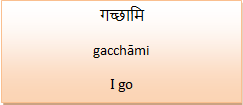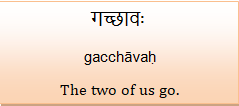Beginning with our first Sanskrit verb,
गच्छामि
gacchāmi
I go
gacchāmi is our first Sanskrit verb which means that the subject is going. The cha has to be spoken with a puff of air as it is an aspirated sound. Notice that in English there are two words but in Sanskrit, there is only one, that means the “I” is somewhere in the word itself.
Now, let’s compare gacchāmi to another verb:
गच्छामः
gacchāmaḥ
We go.
You might have noticed that the ending of the verb has changed. It is because the number of the person has changed. From one person it has become many people. Hence the form of verb changes with the number of subjects. However, you might have noticed that most part of the word has remained same. That is the stem word.
Here we are talking about two things; endings and numbers. What the difference you have seen in both examples is the change in ending. “गच्छामि” , “गच्छामः”. The highlighted part that has changed is called endings. Secondly, the number of people is changed from “I” to “we”, from singular to plural. These two concepts are very important to understand which is important in learning the basic verb and noun formations.
These were the examples of singular and plural. Sanskrit, however, has its ways to refer to two things or persons too i.e. Dual form.
Let us take the example,
गच्छावः
gacchāvaḥ
The two of us go.
Just like in English, we say “you”, “both of you” and “you all”. Sanskrit also has its own forms and endings for a number of persons.
Now let us see another factor of verbs in Sanskrit,
गच्छसि
gacchasi
You go
So far seeing all examples, one thing you must have seen common in all, that is most of the part of all the verbs is same. i.e. “gaccha”. This is called verb stem. For all the verbs in Sanskrit, there is a verb stem, an original word, which changes according to the number of persons.








